
Peter Jansen Wessel Tordenskiold, commonly referred to as Tordenskjold, was a Norwegian nobleman and flag officer who spent his career in the service of the Royal Dano-Norwegian Navy. He rose to the rank of vice-admiral for his services in the Great Northern War. Born in the Norwegian city of Trondheim, Peter Wessel travelled to Copenhagen in 1704 and eventually enlisted in the navy.

Assistens Cemetery in Copenhagen, Denmark, is the burial site of many Danish notables as well as an important greenspace in the Nørrebro district. Inaugurated in 1760, it was originally a burial site for the poor laid out to relieve the crowded graveyards inside the walled city, but during the Golden Age in the first half of the 19th century it became fashionable and many leading figures of the epoch, such as Hans Christian Andersen, Søren Kierkegaard, Christoffer Wilhelm Eckersberg, and Christen Købke are all buried here.
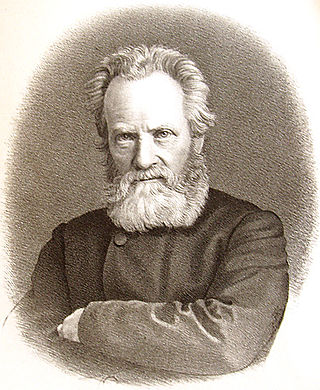
Herman Wilhelm Bissen was a Danish sculptor. Bissen created a number of public works, working in plaster, marble and bronze.

The Isted Lion is a Danish war monument originally intended as a monument of the Danish victory over German-minded Schleswig-Holstein insurgents in the Battle of Isted (Idstedt) on 25 July 1850, during the First Schleswig War which was a civil war within the Danish Realm, although with troops from Prussia supporting the Schleswig-Holstein insurgents. At its time it was the largest battle in Scandinavian history.

The Holmen Church is a Parish church in central Copenhagen in Denmark, on the street called Holmens Kanal. First built as an anchor forge in 1563, it was converted into a naval church by Christian IV. It is famous for having hosted the wedding between Margrethe II of Denmark, queen of Denmark between 1972 and 2024, and Prince Henrik in 1967. It is the burial site of such notabilities as naval heroes Niels Juel and Peter Tordenskjold, and composer Niels Wilhelm Gade, and contains artwork by, among others, Bertel Thorvaldsen and Karel van Mander.

Christian Gottlieb Vilhelm Bissen was a Danish sculptor. He was also a professor at the Royal Danish Academy of Fine Arts with great influence on the next generation of Danish sculptors and for a while served as its director. Bissen was trained in the Neoclassical tradition from Bertel Thorvaldsen but after a stay in Paris around 1880, he was influenced by Naturalism. With the equestrian statue of Absalon he turned to Neo-romanticism.

Theobald Stein was a Danish sculptor. He was a professor at the Royal Danish Academy of Fine Arts and served as its director from 1883 to 1886.

The Tordenskiold family was the name of two dignities in the Danish and the Norwegian nobility. Both are today patrilineally extinct.
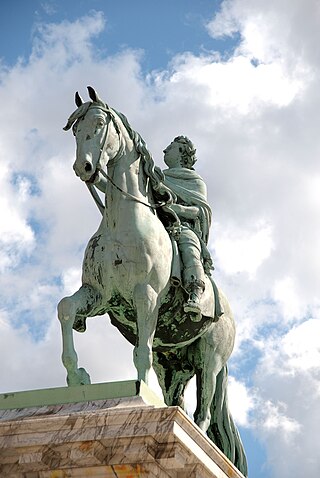
Danish sculpture as a nationally recognized art form can be traced back to 1752 when Jacques Saly was commissioned to execute a statue of King Frederick V of Denmark on horseback. While Bertel Thorvaldsen was undoubtedly the country's most prominent contributor, many other players have produced fine work, especially in the areas of Neoclassicism, Realism, and in Historicism, the latter resulting from growing consciousness of a national identity. More recently, Danish sculpture has been inspired by European trends, especially those from Paris, including Surrealism and Modernism.

Civiletatens Materialgård is a former storage facility at Frederiksholm Canal in Copenhagen, Denmark. The complex was used for the storing of materials used for the royal palaces but also has a long history as home and work place for sculptors associated with the Royal Danish Academy of Fine Arts. Together with the adjacent Fæstningens Materialgård, its military counterpart, and the Royal Horse Guards Barracks, it forms a cluster of low, yellow-washed buildings alongside Frederiksholm Canal. It now houses the Art Academy's School of Sculptury as well as residences.

Carl Christian Ernst Hartmann was a Danish sculptor who worked with antique motifs in the Thorvaldsen tradition.

The equestrian statue of Frederick VII in front of Christiansborg on Slotsholmen in Copenhagen, Denmark, was modelled by Herman Wilhelm Bissen and completed posthumously by his son Vilhelm Bissen in 1873. It was created to commemorate King Frederick's central role in Denmark's transition from absolute to constitutional monarchy.

The Statue of Niels Juel, created by the sculptor Theobald Stein, was unveiled in 1881 at Holmens Kanal in Copenhagen, Denmark. It stands next to Church of Holmen where he is buried and close to his former home in Kongens Nytorv. The monument with surroundings was listed in 2004.
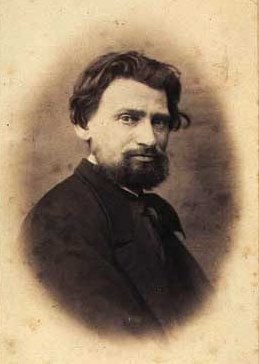
Otto Frederik Theobald Evens was a Danish sculptor.
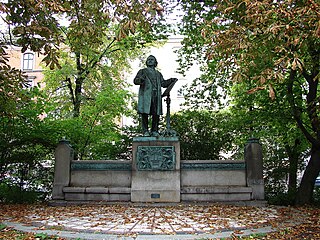
The Statue of Niels W. Gade is a statue of Danish composer Niels W. Gade located in Østre Anlæg in Copenhagen, Denmark. It depicts Gade in the process of conducting Elverskud, one of his most famous works. The monument was originally located on Sankt Annæ Plads but moved to its current location in May 1934.
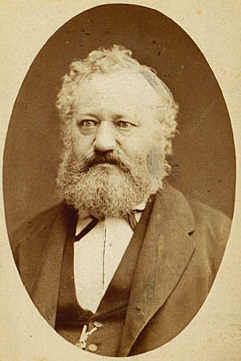
Lauritz Godtfred Rasmussen was a Danish zinc and bronze caster. He established a zinc and bronze foundry in his own name in Copenhagen in 1865 and was appointed royal court caster in 1883. Many Danish monuments from the second half of the 19th century come from his foundry. It was later taken over by his son Carl Rasmussen and remained in the family for several generations.

The statue of Frederick VI greets visitors just inside the main entrance to Frederiksberg Park at Frederiksberg Runddel in the Frederiksberg district of Copenhagen, Denmark. Unveiled on 10 September 1858, the bronze statue was created by Herman Wilhelm Bissen and is considered one of his best works. It is the first public depiction of a Danish monarch in everyday, contemporary attire, rather than that of antiquity, or galla uniform, popular in earlier sculpture.

The statue of Anders Sandøe Ørsted is located in Ørstedsparken in Copenhagen, Denmark. Ørsted was Denmark's leading jurist of the mid-19th century. He served as Prime Minister of Denmark in 1853–54.

Bertel Thorvaldsen with the Statue of Hope is a self-portrait by Danish sculptor Bertel Thorvaldsen, created as a plaster model in his studio at Nysø Manor in 1839 and executed in marble posthumously by Herman Wilhelm Bissen in 1859. In 1894, a bronze cast was erected in Central Park, New York City. Bissen's marble sculpture is on display in the Thorvaldsen Museum in Copenhagen.

The statue of Ludvig Holberg by Theobald Stein, together with Herman Wilhelm Bissen's statue of Adam Oehlenschläger, flanks the main entrance to the Royal Danish Theatre on Kongens Nytorv in Copenhagen, Denmark. It was created by Stein in conjunction with the inauguration of Vilhelm Dahlerup's new theatre building in 1875. Bissen's statue of Oehlenschläger is from 1861 and was originally located on Sankt Annæ Plads.





















